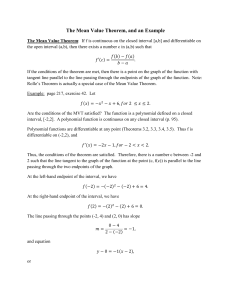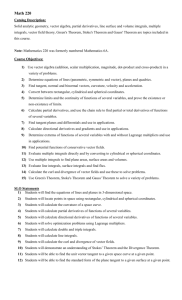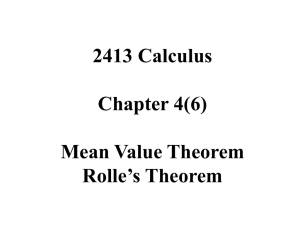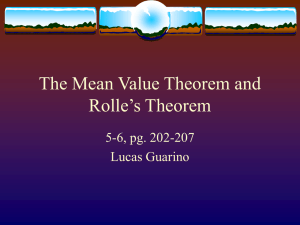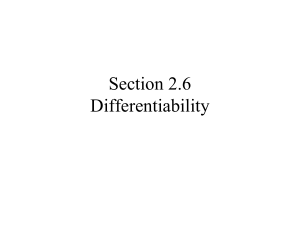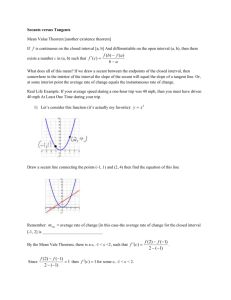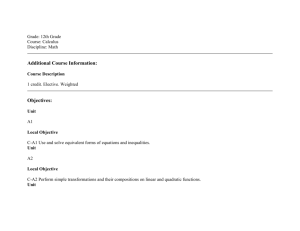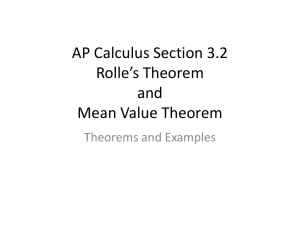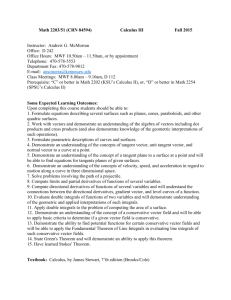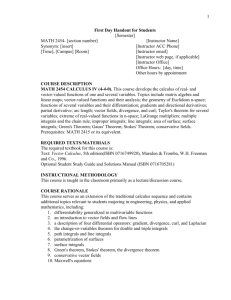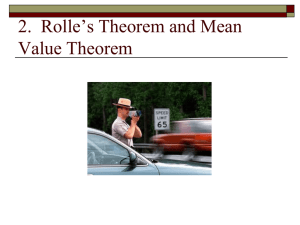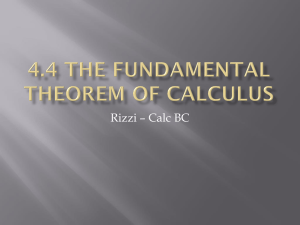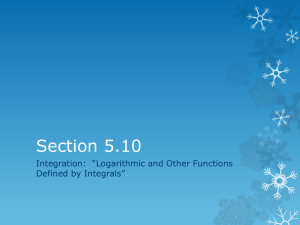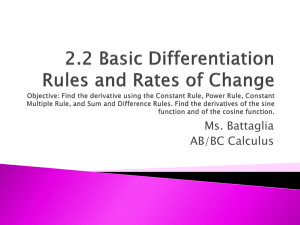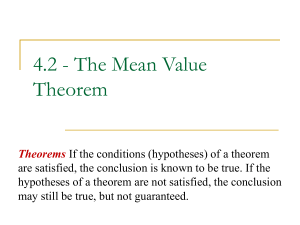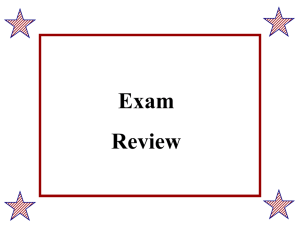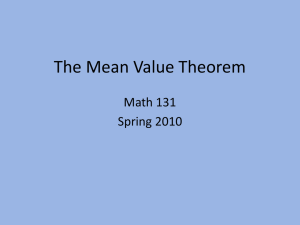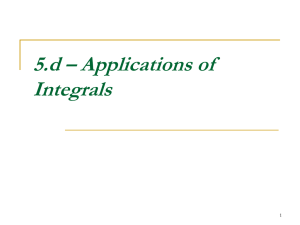Ch. 5 Review: Integrals
advertisement
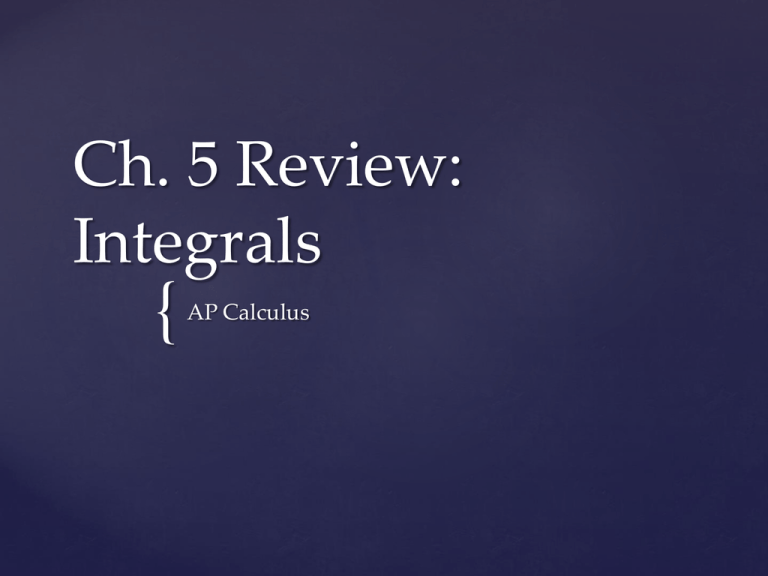
Ch. 5 Review:
Integrals
{
AP Calculus
Ch. 5 Test Topics
5.2: The Differential dy
5.2: Linear Approximation
5.3: Indefinite Integrals
5.4: Riemann Sums (Definite Integrals)
5.5: Mean Value Theorem/Rolle’s Theorem
Tangent line
dx & dy: change in x and y for tangent (derivative)
∆𝑥 𝑎𝑛𝑑 ∆𝑦: 𝑐ℎ𝑎𝑛𝑔𝑒 𝑖𝑛 𝑥 𝑎𝑛𝑑 𝑦 𝑓𝑜𝑟 𝑜𝑟𝑖𝑔𝑖𝑛𝑎𝑙 𝑓𝑢𝑛𝑐𝑡𝑖𝑜𝑛
The Differential dy
𝑑𝑦
= 𝑓 ′ 𝑥 , 𝑠𝑜 𝑑𝑦 = 𝑓′(𝑥) ∙ 𝑑𝑥
𝑑𝑥
Find the differential dy:
y = 3𝑥 2 − 4𝑥 + 2
dy = (6x – 4) dx
Write the equation of the line that best
fits 𝑦 = 3𝑥 2 − 7𝑥 at x = 2. Then find ∆𝑥, ∆𝑦,
dx, and dy if f(2.01) is approximated.
∆𝑥
Equation:
∆𝑦
dx
dy
Linear Approximation
Write the equation of the line that best
fits 𝑦 = 3𝑥 2 − 7𝑥 at x = 2. Then find ∆𝑥, ∆𝑦,
dx, and dy if f(2.01) is approximated.
Point of tangency: f(2) = -2
Slope of tangent (deriv):
y’ = 6x – 7 when x = 2 5
Sub into pt-slope equation:
y – 𝑦1 = 𝑚(𝑥 − 𝑥1 )
y + 2 = 5(x – 2) y = 5x – 12
If x = 2.01, y = -1.95
∆𝑥: Function change in x: 2.01 − 2 = .01
∆𝑦 : Function change in y: f(2.01) – f(2) = .0503
dx: Tangent line change in x -- 2.01 – 2 = .01
dy: Tangent line change in y for x = 2 to 2.01: -1.95 - -2 = .05
or dy = f’(x) dx at x = 2 (6(2) – 7)(.01) = .05
Linear Approximation
If a function is
continuous and
differentiable on the
interval [a, b], then there
is at least one point x = c
at which the slope of the
tangent equals the slope
of the secant connecting
f(a) and f(b)
Mean Value Theorem
If a function f is:
1)
Differentiable for all values of x in the
open interval (a, b) and
2)
Continuous for all values of x in the
closed interval [a, b]
Then there is at least one number x = c in
(a, b) such that
f’(c) =
𝑓 𝑏 −𝑓(𝑎)
𝑏−𝑎
Mean Value Theorem (MVT)
If a function is
differentiable and
continuous on the
interval [a, b], and
f(a) = f(b) = 0, then
there is at least one
value x = c such
that f’(c) = 0.
Rolle’s Theorem
Remember – Function must be
CONTINUOUS and DIFFERENTIABLE on
interval! Otherwise, conclusion of MVT may
not be met.
Mean Value Theorem
8𝑥 1/3 𝑑𝑥 =
5𝑥 4 + 1 𝑑𝑥 =
(7𝑥 + 3)8 𝑑𝑥 =
5𝑠𝑖𝑛2𝑥 𝑑𝑥 =
𝑠𝑒𝑐5𝑥 tan 5𝑥 𝑑𝑥 =
Integrals Self-Quiz
8𝑥 1/3 𝑑𝑥 = 6𝑥 4/3 + 𝑐
5𝑥 4 + 1 𝑑𝑥 = 𝑥 5 + 𝑥 + 𝑐
(7𝑥 +
3)8 𝑑𝑥
1
=
(7𝑥 + 3)9 +𝑐
63
5
5𝑠𝑖𝑛2𝑥 𝑑𝑥 = − cos 2𝑥 + 𝑐
2
1
𝑠𝑒𝑐5𝑥 tan 5𝑥 𝑑𝑥 = sec 5𝑥 + 𝑐
5
Integrals Self-Quiz
𝑒 sin 𝑥 𝑐𝑜𝑠𝑥 𝑑𝑥 =
𝑥(𝑥 2 − 3)5 𝑑𝑥 =
𝑐𝑜𝑠 4 𝑥 𝑠𝑖𝑛𝑥 𝑑𝑥 =
2𝑥 𝑥 3 − 7 𝑑𝑥 =
Integrals Self-Quiz
𝑒 sin 𝑥 𝑐𝑜𝑠𝑥 𝑑𝑥 = 𝑒 𝑠𝑖𝑛𝑥 + 𝑐
𝑥(𝑥 2
− 3)5 𝑑𝑥
1 2
=
(𝑥 − 3)6 +𝑐
12
1
𝑐𝑜𝑠 𝑥 𝑠𝑖𝑛𝑥 𝑑𝑥 = − 𝑐𝑜𝑠 5 𝑥 + 𝑐
5
4
2𝑥
𝑥3
2 5
− 7 𝑑𝑥 = 𝑥 − 7𝑥 2 + 𝑐
5
Integrals Self-Quiz
R Problems, pg. 260:
R1 –R5 ab
